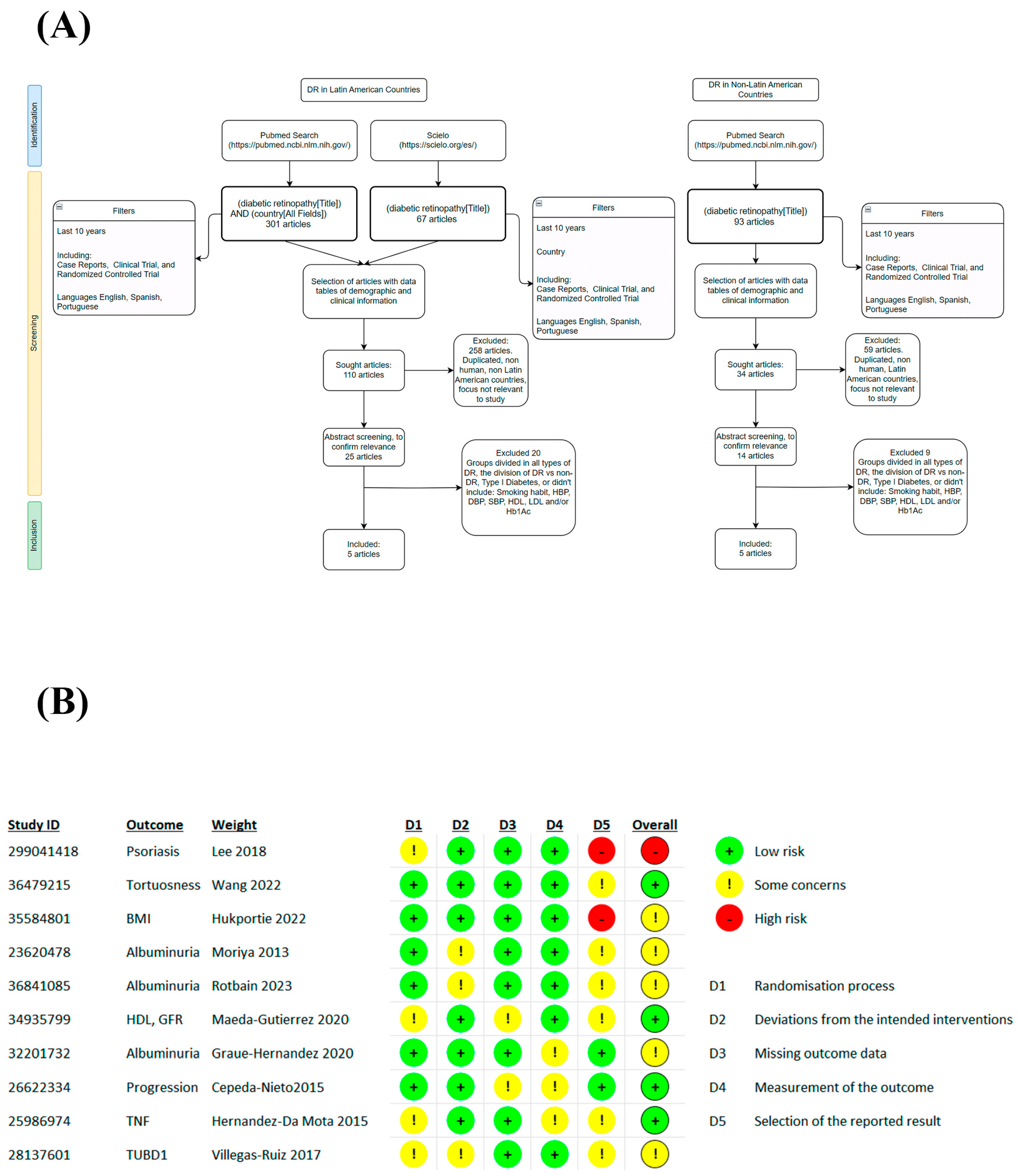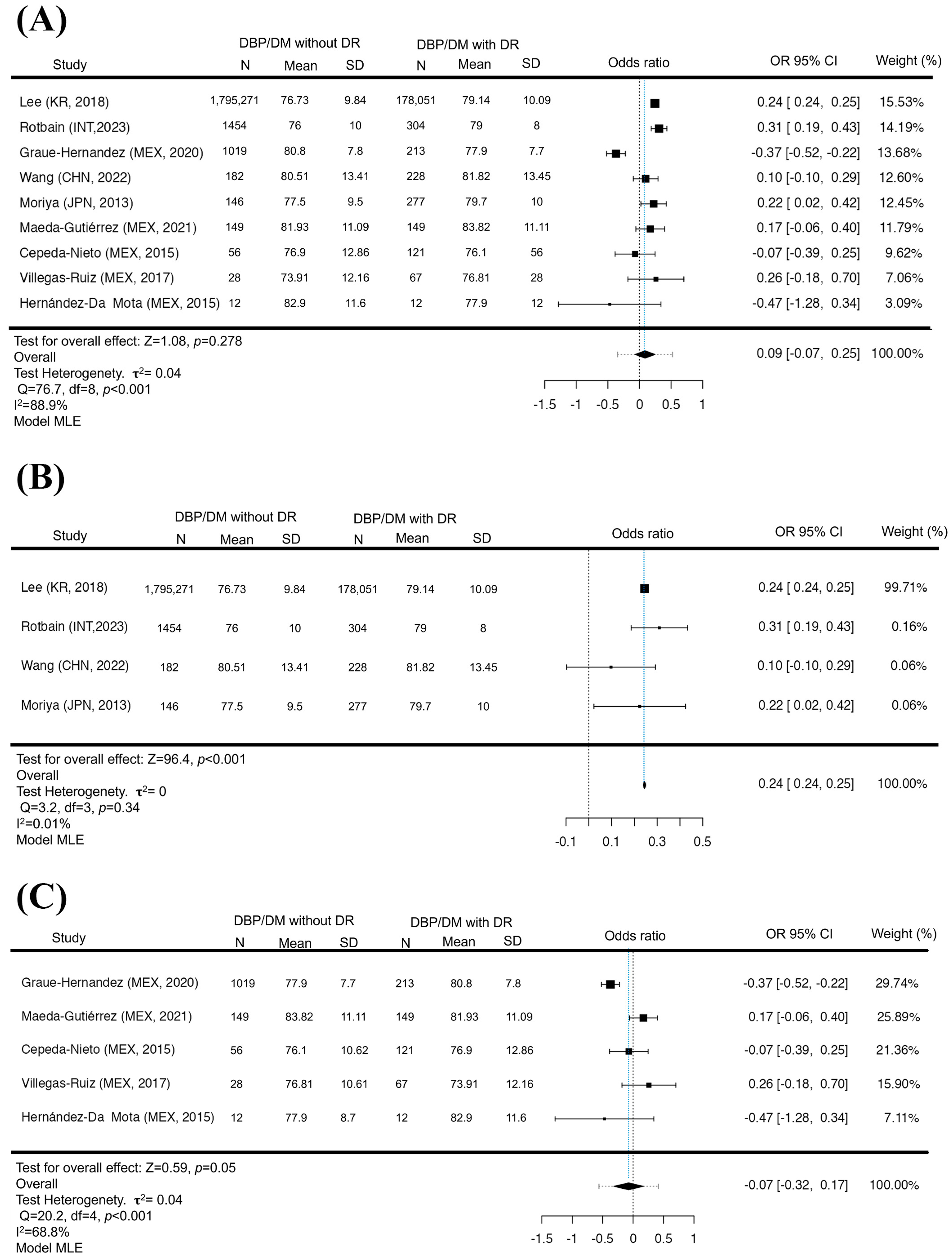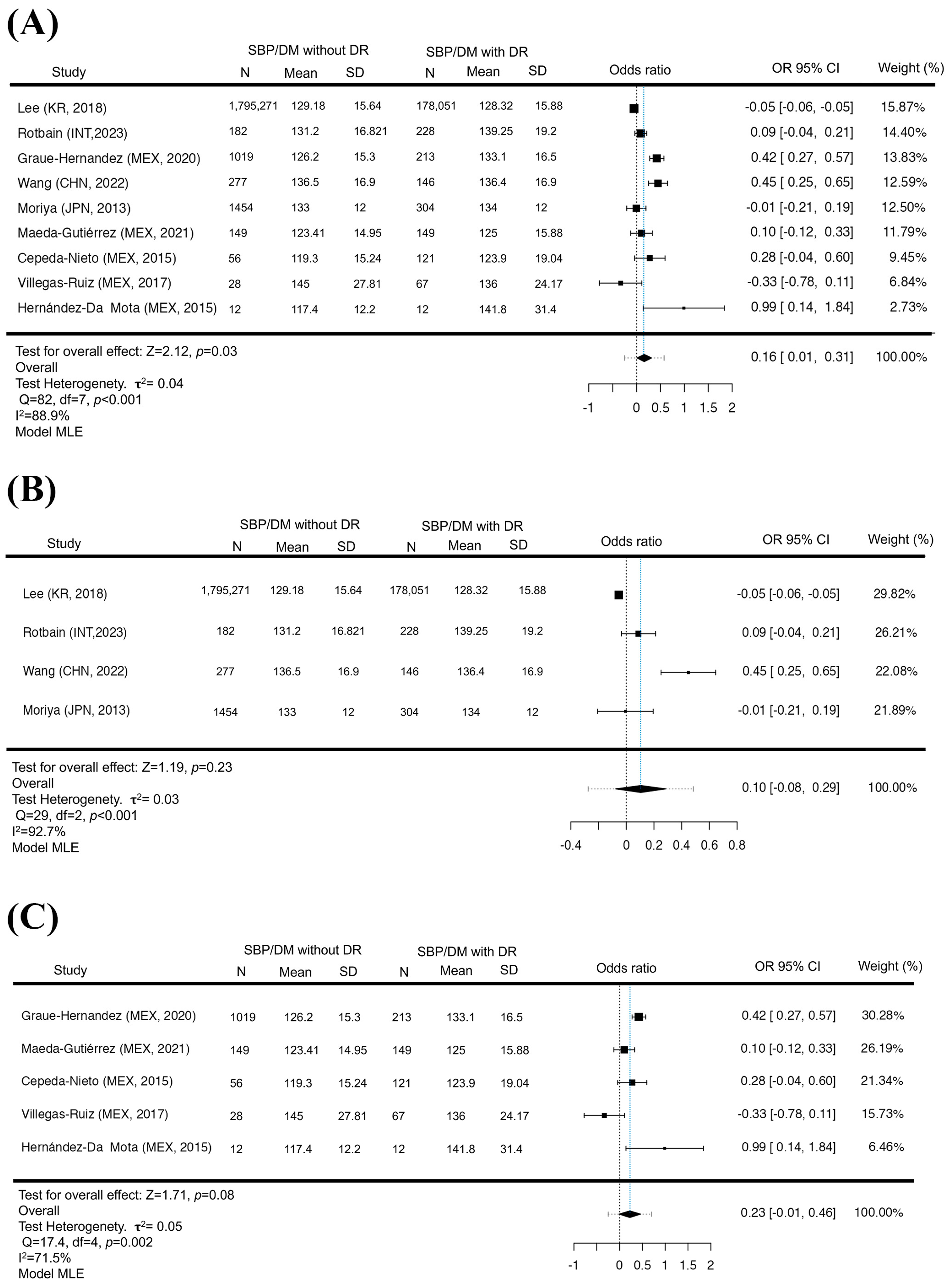Risk Factors for Diabetic Retinopathy in Latin America (Mexico) and the World: A Systematic Review and Meta-Analysis
Abstract
1. Introduction
1.1. Overview of Diabetes in the World
1.2. Pathology of Diabetic Retinopathy
1.3. Ethnic Differences in the DR
1.4. Diabetic Retinopathy in Latin America
2. Materials and Methods
2.1. Registration
2.2. LATAM Systematic Search
2.3. Non-LATAM Systematic Search
2.4. Inclusion and Removal Criteria
2.5. Quality Assessment
2.6. Data Extraction
2.7. Statistical Analysis
2.8. Meta-Analysis
3. Results
3.1. DBP as a Possible Risk Factor for DR in a Non-Latin American Population
3.2. Increased SBP as a Risk Factor for DR for GL
4. Discussion
5. Conclusions
6. Future Research
7. Limitations
Supplementary Materials
Author Contributions
Funding
Institutional Review Board Statement
Informed Consent Statement
Data Availability Statement
Conflicts of Interest
References
- IDF. International Diabetes Federation. IDF Diabetes Atlas, 10th ed.; IDF: Brussels, Belgium, 2021. [Google Scholar]
- Aschner, P.; Aguilar-Salinas, C.; Aguirre, L.; Franco, L.; Gagliardino, J.J.; de Lapertosa, S.G.; Seclen, S.; Vinocour, M. Diabetes in South and Central America: An update. Diabetes Res. Clin. Pract. 2014, 103, 238–243. [Google Scholar] [CrossRef] [PubMed]
- Saeedi, P.; Petersohn, I.; Salpea, P.; Malanda, B.; Karuranga, S.; Unwin, N.; Colagiuri, S.; Guariguata, L.; Motala, A.A.; Ogurtsova, K.; et al. Global and regional diabetes prevalence estimates for 2019 and projections for 2030 and 2045: Results from the International Diabetes Federation Diabetes Atlas, 9th edition. Diabetes Res. Clin. Pract. 2019, 157, 107843. [Google Scholar] [CrossRef] [PubMed]
- PAHO. Panorama of Diabetes in the Americas; PAHO: Washington, DC, USA, 2022. [Google Scholar] [CrossRef]
- Fowler, M.J. Microvascular and Macrovascular Complications of Diabetes. Clin. Diabetes 2008, 26, 77–82. [Google Scholar] [CrossRef]
- Carrillo-Larco, R.M.; Barengo, N.C.; Albitres-Flores, L.; Bernabe-Ortiz, A. The risk of mortality among people with type 2 diabetes in Latin America: A systematic review and meta-analysis of population-based cohort studies. Diabetes/Metab. Res. Rev. 2019, 35, e3139. [Google Scholar] [CrossRef]
- Wong, T.Y.; Cheung, C.M.; Larsen, M.; Sharma, S.; Simó, R. Diabetic retinopathy. Nat. Rev. Dis. Primers 2016, 2, 16012. [Google Scholar] [CrossRef] [PubMed]
- Teo, Z.L.; Tham, Y.C.; Yu, M.; Chee, M.L.; Rim, T.H.; Cheung, N.; Bikbov, M.M.; Wang, Y.X.; Tang, Y.; Lu, Y.; et al. Global Prevalence of Diabetic Retinopathy and Projection of Burden through 2045: Systematic Review and Meta-analysis. Ophthalmology 2021, 128, 1580–1591. [Google Scholar] [CrossRef]
- Yamamoto, H.; Rundqvist, H.; Branco, C.; Johnson, R.S. Autocrine VEGF Isoforms Differentially Regulate Endothelial Cell Behavior. Front. Cell Dev. Biol. 2016, 4, 99. [Google Scholar] [CrossRef]
- Alon, T.; Hemo, I.; Itin, A.; Pe’er, J.; Stone, J.; Keshet, E. Vascular endothelial growth factor acts as a survival factor for newly formed retinal vessels and has implications for retinopathy of prematurity. Nat. Med. 1995, 1, 1024–1028. [Google Scholar] [CrossRef]
- Simó, R.; Stitt, A.W.; Gardner, T.W. Neurodegeneration in diabetic retinopathy: Does it really matter? Diabetologia 2018, 61, 1902–1912. [Google Scholar] [CrossRef]
- Carelli, V.; La Morgia, C.; Valentino, M.L.; Barboni, P.; Ross-Cisneros, F.N.; Sadun, A.A. Retinal ganglion cell neurodegeneration in mitochondrial inherited disorders. Biochim. Biophys. Acta 2009, 1787, 518–528. [Google Scholar] [CrossRef]
- Zeng, H.Y.; Green, W.R.; Tso, M.O. Microglial activation in human diabetic retinopathy. Arch. Ophthalmol. 2008, 126, 227–232. [Google Scholar] [CrossRef]
- Early Treatment Diabetic Retinopathy Study Research Group. Grading Diabetic Retinopathy from Stereoscopic Color Fundus Photographs—An Extension of the Modified Airlie House Classification: ETDRS Report Number 10. Ophthalmology 1991, 98, 786–806. [Google Scholar] [CrossRef]
- Feizi, S.; Azari, A.A.; Safapour, S. Therapeutic approaches for corneal neovascularization. Eye Vis. 2017, 4, 28. [Google Scholar] [CrossRef]
- Tarr, J.M.; Kaul, K.; Chopra, M.; Kohner, E.M.; Chibber, R. Pathophysiology of diabetic retinopathy. ISRN Ophthalmol. 2013, 2013, 343560. [Google Scholar] [CrossRef] [PubMed]
- Nagy, T.; Fisi, V.; Frank, D.; Kátai, E.; Nagy, Z.; Miseta, A. Hyperglycemia-Induced Aberrant Cell Proliferation; A Metabolic Challenge Mediated by Protein O-GlcNAc Modification. Cells 2019, 8, 999. [Google Scholar] [CrossRef] [PubMed]
- Gillow, J.T.; Gibson, J.M.; Dodson, P.M. Hypertension and diabetic retinopathy—What’s the story? Br. J. Ophthalmol. 1999, 83, 1083. [Google Scholar] [CrossRef] [PubMed]
- Raman, R.; Rani, P.K.; Kulothungan, V.; Reddi Rachepalle, S.; Kumaramanickavel, G.; Sharma, T. Influence of Serum Lipids on Clinically Significant versus Nonclinically Significant Macular Edema: SN-DREAMS Report Number 13. Ophthalmology 2010, 117, 766–772. [Google Scholar] [CrossRef]
- Klein, R.; Klein, B.E.K.; Moss, S.E. Is Obesity Related to Microvascular and Macrovascular Complications in Diabetes? The Wisconsin Epidemiologic Study of Diabetic Retinopathy. Arch. Intern. Med. 1997, 157, 650–656. [Google Scholar] [CrossRef]
- Kola, L.D.; Sumaili, E.K.; Krzesinski, J.M. How to Treat Hypertension in blacks: Review of teh evidence. Acta Clin. Belg. 2009, 64, 466–476. [Google Scholar] [CrossRef]
- Wulan, S.N.; Westerterp, K.R.; Plasqui, G. Ethnic differences in body composition and the associated metabolic profile: A comparative study between Asians and Caucasians. Maturitas 2010, 65, 315–319. [Google Scholar] [CrossRef]
- Herman, W.H.; Dungan, K.M.; Wolffenbuttel, B.H.R.; Buse, J.B.; Fahrbach, J.L.; Jiang, H.; Martin, S. Racial and Ethnic Differences in Mean Plasma Glucose, Hemoglobin A1c, and 1,5-Anhydroglucitol in Over 2000 Patients with Type 2 Diabetes. J. Clin. Endocrinol. Metab. 2009, 94, 1689–1694. [Google Scholar] [CrossRef] [PubMed]
- Lanting, L.C.; Joung, I.M.A.; Mackenbach, J.P.; Lamberts, S.W.J.; Bootsma, A.H. Ethnic Differences in Mortality, End-Stage Complications, and Quality of Care Among Diabetic Patients: A review. Diabetes Care 2005, 28, 2280–2288. [Google Scholar] [CrossRef] [PubMed]
- Pérez-Escamilla, R.; Putnik, P. The Role of Acculturation in Nutrition, Lifestyle, and Incidence of Type 2 Diabetes among Latinos1. J. Nutr. 2007, 137, 860–870. [Google Scholar] [CrossRef]
- Nguyen, T.T.; Wang, J.J.; Sharrett, A.R.; Islam, F.M.A.; Klein, R.; Klein, B.E.K.; Cotch, M.F.; Wong, T.Y. Relationship of Retinal Vascular Caliber With Diabetes and Retinopathy: The Multi-Ethnic Study of Atherosclerosis (MESA). Diabetes Care 2008, 31, 544–549. [Google Scholar] [CrossRef] [PubMed]
- Avilés-Santa, M.L.; Monroig-Rivera, A.; Soto-Soto, A.; Lindberg, N.M. Current State of Diabetes Mellitus Prevalence, Awareness, Treatment, and Control in Latin America: Challenges and Innovative Solutions to Improve Health Outcomes Across the Continent. Curr. Diabetes Rep. 2020, 20, 62. [Google Scholar] [CrossRef]
- Limburg, H.; von-Bischhoffshausen, F.B.; Gomez, P.; Silva, J.C.; Foster, A. Review of recent surveys on blindness and visual impairment in Latin America. Br. J. Ophthalmol. 2008, 92, 315–319. [Google Scholar] [CrossRef]
- Lachin, J.M.; Genuth, S.; Nathan, D.M.; Zinman, B.; Rutledge, B.N. Effect of glycemic exposure on the risk of microvascular complications in the diabetes control and complications trial-revisited. Diabetes 2008, 57, 995–1001. [Google Scholar] [CrossRef]
- Cabrera, A.P.; Monickaraj, F.; Rangasamy, S.; Hobbs, S.; McGuire, P.; Das, A. Do Genomic Factors Play a Role in Diabetic Retinopathy? J. Clin. Med. 2020, 9, 216. [Google Scholar] [CrossRef]
- Higgins, J.P.; Savović, J.; Page, M.J.; Elbers, R.G.; Sterne, J.A. Assessing risk of bias in a randomized trial. In Cochrane Handbook for Systematic Reviews of Interventions; Wiley: Hoboken, NJ, USA, 2019; pp. 205–228. [Google Scholar] [CrossRef]
- Maeda-Gutiérrez, V.; Galván-Tejada, C.E.; Cruz, M.; Galván-Tejada, J.I.; Gamboa-Rosales, H.; García-Hernández, A.; Luna-García, H.; Gonzalez-Curiel, I.; Martínez-Acuña, M. Risk-Profile and Feature Selection Comparison in Diabetic Retinopathy. J. Pers. Med. 2021, 11, 1327. [Google Scholar] [CrossRef]
- Graue-Hernandez, E.O.; Rivera-De-La-Parra, D.; Hernandez-Jimenez, S.; Aguilar-Salinas, C.A.; Kershenobich-Stalnikowitz, D.; Jimenez-Corona, A. Prevalence and associated risk factors of diabetic retinopathy and macular oedema in patients recently diagnosed with type 2 diabetes. BMJ Open Ophthalmol. 2020, 5, e000304. [Google Scholar] [CrossRef]
- Hernández-Da Mota, S.E.; Soto-Bahena, J.J.; Viveros-Sandoval, M.E.; Cardiel-Ríos, M. Pro-inflammatory serum cytokines in diabetic retinopathy. Cir. Cir. 2015, 83, 100–106. [Google Scholar] [CrossRef] [PubMed]
- Villegas-Ruiz, V.; Hendlmeier, F.; Buentello-Volante, B.; Rodríguez-Loaiza, J.L.; Miranda-Duarte, A.; Zenteno, J.C. Genome-wide mRNA analysis reveals a TUBD1 isoform profile as a potential biomarker for diabetic retinopathy development. Exp. Eye Res. 2017, 155, 99–106. [Google Scholar] [CrossRef] [PubMed]
- Cepeda-Nieto, A.C.; Esquivel-Contreras, M.T.; Duran-Iñiguez, F.; Salinas-Santander, M.A.; Gallardo-Blanco, H.L.; Esparza-González, S.C.; Zugasti-Cruz, A.; Morlett-Chávez, J.A.; Córdova-Alvelais, L.T. High prevalence of diabetic retinopathy and lack of association with integrin α2 gene polymorphisms in patients with type 2 diabetes from Northeastern Mexico. Exp. Ther. Med. 2015, 10, 435–444. [Google Scholar] [CrossRef] [PubMed]
- Wang, M.; Zhou, X.; Liu, D.N.; Chen, J.; Zheng, Z.; Ling, S. Development and validation of a predictive risk model based on retinal geometry for an early assessment of diabetic retinopathy. Front. Endocrinol. 2022, 13, 1033611. [Google Scholar] [CrossRef]
- Rotbain Curovic, V.; Tofte, N.; Lindhardt, M.; Adamova, K.; Bakker, S.J.L.; Beige, J.; Beulens, J.W.J.; Birkenfeld, A.L.; Currie, G.; Delles, C.; et al. Presence of retinopathy and incident kidney and cardiovascular events in type 2 diabetes with normoalbuminuria—A post-hoc analysis of the PRIORITY randomized clinical trial. J. Diabetes Complicat. 2023, 37, 108433. [Google Scholar] [CrossRef]
- Moriya, T.; Tanaka, S.; Kawasaki, R.; Ohashi, Y.; Akanuma, Y.; Yamada, N.; Sone, H.; Yamashita, H.; Katayama, S. Diabetic retinopathy and microalbuminuria can predict macroalbuminuria and renal function decline in Japanese type 2 diabetic patients: Japan Diabetes Complications Study. Diabetes Care 2013, 36, 2803–2809. [Google Scholar] [CrossRef]
- Hukportie, D.N.; Li, F.R.; Zhou, R.; Zheng, J.Z.; Wu, X.X.; Wu, X.B. Waist Circumference and Body Mass Index Variability and Incident Diabetic Microvascular Complications: A Post Hoc Analysis of ACCORD Trial. Diabetes Metab. J. 2022, 46, 767–780. [Google Scholar] [CrossRef]
- Lee, J.H.; Han, J.H.; Han, K.D.; Park, Y.M.; Lee, J.Y.; Park, Y.-G.; Lee, Y.B. Psoriasis risk in patients with diabetic retinopathy: A nationwide population-based study. Sci. Rep. 2018, 8, 9086. [Google Scholar] [CrossRef]
- López-Letayf, S.; Vivanco-Rojas, Ó.; Londoño-Angarita, V.; Garfias, Y. Risk factors in diabetic retinopathy, a Latin American perspective. Asoc. Latinoam. De Diabetes 2023, 34, 29–40. [Google Scholar] [CrossRef]
- Li, Y.-T.; Wang, Y.; Hu, X.-J.; Chen, J.-H.; Li, Y.-Y.; Zhong, Q.-Y.; Cheng, H.; Mohammed, B.H.; Liang, X.-L.; Hernandez, J.; et al. Association between Systolic Blood Pressure and Diabetic Retinopathy in Both Hypertensive and Normotensive Patients with Type 2 Diabetes: Risk Factors and Healthcare Implications. Healthcare 2021, 9, 580. [Google Scholar] [CrossRef]
- Liu, Y.; Wang, M.; Morris, A.D.; Doney, A.S.; Leese, G.P.; Pearson, E.R.; Palmer, C.N. Glycemic exposure and blood pressure influencing progression and remission of diabetic retinopathy: A longitudinal cohort study in GoDARTS. Diabetes Care 2013, 36, 3979–3984. [Google Scholar] [CrossRef]
- Rezaei, M.; Rabizadeh, S.; Mirahmad, M.; Hajmiri, M.S.; Nakhjavani, M.; Hemmatabadi, M.; Shirzad, N. The association between advanced glycation end products (AGEs) and ABC (hemoglobin A1C, blood pressure, and low-density lipoprotein cholesterol) control parameters among patients with type 2 diabetes mellitus. Diabetol. Metab. Syndr. 2022, 14, 122. [Google Scholar] [CrossRef]
- Kifley, A.; Wang, J.J.; Cugati, S.; Wong, T.Y.; Mitchell, P. Retinal Vascular Caliber, Diabetes, and Retinopathy. Am. J. Ophthalmol. 2007, 143, 1024–1026. [Google Scholar] [CrossRef] [PubMed]
- Pickering, T.G. Hypertension in Hispanics. J. Clin. Hypertens. 2004, 6, 279–282. [Google Scholar] [CrossRef] [PubMed]
- Ordúñez-García, P.O.; Espinosa-Brito, A.D.; Cooper, R.S.; Kaufman, J.S.; Nieto, F.J. Hypertension in Cuba: Evidence of a narrow black–white difference. J. Hum. Hypertens. 1998, 12, 111–116. [Google Scholar] [CrossRef] [PubMed][Green Version]
- Lou, Q.; Chen, X.; Wang, K.; Liu, H.; Zhang, Z.; Lee, Y. The Impact of Systolic Blood Pressure, Pulse Pressure, and Their Variability on Diabetes Retinopathy among Patients with Type 2 Diabetes. J. Diabetes Res. 2022, 2022, 7876786. [Google Scholar] [CrossRef] [PubMed]
- Bulum, T.; Tomić, M.; Vrabec, R.; Brkljačić, N.; Ljubić, S. Systolic and Diastolic Blood Pressure Are Independent Risk Factors for Diabetic Retinopathy in Patients with Type 2 Diabetes. Biomedicines 2023, 11, 2242. [Google Scholar] [CrossRef] [PubMed]
- West, S.K.; Klein, R.; Rodriguez, J.; Muñoz, B.; Broman, A.T.; Sanchez, R.; Snyder, R. Diabetes and Diabetic Retinopathy in a Mexican-American Population: Proyecto VER. Diabetes Care 2001, 24, 1204–1209. [Google Scholar] [CrossRef]
- Nittala, M.G.; Keane, P.A.; Zhang, K.; Sadda, S.R. Risk factors for proliferative diabetic retinopathy in a latino american population. Retina 2014, 34, 1594–1599. [Google Scholar] [CrossRef]
- Ministério da Saúde. Vigilância de Fatores de Risco e Proteção para Doenças Crônicas por Inquérito Telefônico (Vigitel Brasil 2019); Brasil, Ministério da Saúde: Brasilia, Brazil, 2019.
- Basto-Abreu, A.; Barrientos-Gutiérrez, T.; Rojas-Martínez, R.; Aguilar-Salinas, C.A.; López-Olmedo, N.; De la Cruz-Góngora, V.; Rivera-Dommarco, J.; Shamah-Levy, T.; Romero-Martínez, M.; Barquera, S.; et al. Prevalencia de diabetes y descontrol glucémico en México: Resultados de la Ensanut 2016. Salud Pública México 2019, 62, 50–59. [Google Scholar] [CrossRef]
- Campos-Nonato, I.; Hernández-Barrera, L.; Oviedo-Solís, C.; Ramírez-Villalobos, D.; Hernández-Prado, B.; Barquera, S. Epidemiología de la hipertensión arterial en adultos mexicanos: Diagnóstico, control y tendencias. Ensanut 2020. Salud Pública México 2021, 63, 692–704. [Google Scholar] [CrossRef] [PubMed]



| Author | Country | Risk Factor or Biomarker Studied | Total N | Relevance for DR |
|---|---|---|---|---|
| Maeda-Gutiérrez V et al. [32] | Mexico | Analisys of risk factors using machine learning to select features and create predictive models for DR | 298 | Feature selection for the prediction of high-risk patients using common measurements of diabetes, is a quick and cheap way of creating accessible diagnostic aids, specially when there is no access to specialized equipment |
| Graue-Hernandez EO et al. [33] | Mexico | Several metabolic risk factor were analized in realtionship to recent DR diagnosis and Diabetes duration | 1232 | The population analyzed was Mexican, and it demonstrated the association of DR with diabetes in patients recently diagnosed with Diabetes type 2, meaning that for this population screening for DR at the moment of diagnosis is necessary. It also noted that for this sample lack of glucose control and high SBP were also associated risk factors for DR. |
| Cepeda-Nieto AC et al. [36] | Mexico | Integrin α2 gene polymorhisms | 177 | The polymorphism known as 807T and 807C associated with restriction zones BglII/NdeI has been associated in Japanese and Caucasian population as a risk factor for DR but are not present in the Mexican population analyzed. |
| Hernández-Da Mota SE et al. [34] | Mexico | Pro-inflammatory citokines, TNF-α, IL-1β, and IL-6, and pro-inflammatory biomarkers, CRP, and globular sedimentation rate. | 24 | The inflammatory process is considered part of the pathogenesis of DR, in the population studied TNF-α was higher in patients with DR. |
| Villegas-Ruiz V et al. [35] | Mexico | TUBD1 isoform a and b | 95 | In the analysis made by the authors, they discovered that this two isoforms were elevated in patients with DR, and that the isoforms were regulated by HIF-1 a molecule also involved in the regulation of VEGF |
| Lee JH et al. [41] | Republic Korea | Psoriasis risk in patients with DR and ESRD | 1,973,322 | Psoriasis was prevalent among patients with DR and ESRD, this is relevant because psoriasis being an inflammatory disease, confirms that there is presence of an inflammatory process in diabetic patients, also that the effects of angiogenesis are not limited to retina and might be a systemic issue for this patients. |
| Wang M et al. [37] | China | Retinal geometry to assess DR | 410 | In this study during the analysis of their model to assess DR, found like other studies that one of the most important risk factors for DR is duration of diabetes |
| Hukportie DN et al. [40] | International | Waist circunference and BMI | 6217 | This study didn’t find correlation between waist circumference and BMI and DR |
| Moriya T et al. [39] | Japon | Macroalbuminuria risk in relation with DR | 423 | DR might reflect on the microvascular state of the kidney, leading to lower GFR and in consequence macroalbuminuria. |
| Rotbain Curovic V et al. [38] | International | Albuminuria | 1758 | Presence of DR, may increase the risk of presenting macroalbuminuria. |
Disclaimer/Publisher’s Note: The statements, opinions and data contained in all publications are solely those of the individual author(s) and contributor(s) and not of MDPI and/or the editor(s). MDPI and/or the editor(s) disclaim responsibility for any injury to people or property resulting from any ideas, methods, instructions or products referred to in the content. |
© 2023 by the authors. Licensee MDPI, Basel, Switzerland. This article is an open access article distributed under the terms and conditions of the Creative Commons Attribution (CC BY) license (https://creativecommons.org/licenses/by/4.0/).
Share and Cite
Vivanco-Rojas, O.; López-Letayf, S.; Londoño-Angarita, V.; Magaña-Guerrero, F.S.; Buentello-Volante, B.; Garfias, Y. Risk Factors for Diabetic Retinopathy in Latin America (Mexico) and the World: A Systematic Review and Meta-Analysis. J. Clin. Med. 2023, 12, 6583. https://doi.org/10.3390/jcm12206583
Vivanco-Rojas O, López-Letayf S, Londoño-Angarita V, Magaña-Guerrero FS, Buentello-Volante B, Garfias Y. Risk Factors for Diabetic Retinopathy in Latin America (Mexico) and the World: A Systematic Review and Meta-Analysis. Journal of Clinical Medicine. 2023; 12(20):6583. https://doi.org/10.3390/jcm12206583
Chicago/Turabian StyleVivanco-Rojas, Oscar, Sonia López-Letayf, Valentina Londoño-Angarita, Fátima Sofía Magaña-Guerrero, Beatriz Buentello-Volante, and Yonathan Garfias. 2023. "Risk Factors for Diabetic Retinopathy in Latin America (Mexico) and the World: A Systematic Review and Meta-Analysis" Journal of Clinical Medicine 12, no. 20: 6583. https://doi.org/10.3390/jcm12206583
APA StyleVivanco-Rojas, O., López-Letayf, S., Londoño-Angarita, V., Magaña-Guerrero, F. S., Buentello-Volante, B., & Garfias, Y. (2023). Risk Factors for Diabetic Retinopathy in Latin America (Mexico) and the World: A Systematic Review and Meta-Analysis. Journal of Clinical Medicine, 12(20), 6583. https://doi.org/10.3390/jcm12206583






